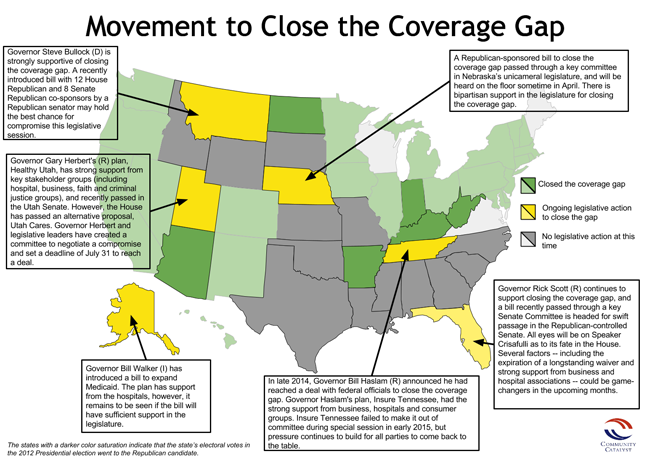A few recent headlines suggest that red states stopped making progress on closing the coverage gap. These headlines fit neatly into the “Republicans block ObamaCare” storyline that dominates other aspects of ACA implementation, but they don’t accurately describe the coverage gap debate.
Regardless of your party affiliation, the benefits of closing the coverage gap are hard to ignore. Within the past few weeks, new studies of states that already accepted the federal dollars confirmed that closing the coverage gap not only provides health security to millions of low-income Americans, it frees up money in state budgets and creates new jobs.
Since when are Democrats the only ones interested in reducing state spending and boosting employment? They’re not. That’s why poll after poll shows that closing the coverage gap has strong public support, even among conservative voters. And it’s why 15 Republican Governors have come out in support of closing the coverage gap since 2012.
Now, let’s be real: it’s usually harder to get an expansion bill through a Republican-dominated legislature than it is to gain support of a Republican governor (though this isn’t always the case - sorry, Maine!). Indeed, a few plans developed by Republican governors recently hit roadblocks in their statehouses. Unlike governors who heed to statewide support, many Republican legislative leaders’ districts are so conservative that their biggest fear is getting Eric Cantored – making them vulnerable to Tea Party demands.
Despite the disproportionate Tea Party influence in many statehouses, at least six Republican-dominated legislatures are actively working to build a compromise to close the coverage gap this year. This progress is often driven by establishment Republicans who are fed up with their party being hijacked by the far-right.
 Download the map here.
Download the map here.
That’s not even the complete picture. The last six months saw a rash of high-profile Republican leaders reversing their earlier opposition to closing the coverage gap. For example, Governor Bentley (R-AL) recently indicated that he’s open to exploring a waiver to close the coverage gap, as did Governor McCrory (R-NC). Governor Otter (R-ID) has implored his state to find a solution to the gap, as has Governor Mead (R-WY). And the Republican-dominated legislature in Kansas held hearings this week to discuss the benefits of closing the coverage gap.
It’s too early to tell in which states these bills will survive the legislative process and make it into law. If all six of the most promising states closed the coverage gap this year, nearly 2 million more people would have access to affordable health care by 2016. While we certainly wish it would happen faster, it’s safe to say that red states are making slow but steady progress toward closing the coverage gap.
